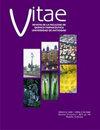非洲棕榈果实铜绿假单胞菌脂溶酶诱导作用的研究
Q3 Pharmacology, Toxicology and Pharmaceutics
引用次数: 4
摘要
背景:当发酵处于指数期结束时,在培养液中发现细胞外脂肪酶。脂肪酶很容易被诱导,因为它们是由油源或其他物质如表面活性剂、脂肪酸、某些酯类、甘油和胆盐产生的。目的:研究碳源浓度和诱导剂的使用对成熟棕榈油果实中分离的一种细菌的生物量产生和脂解活性的影响。方法:以葡萄糖为碳源,在不同浓度(3、5、7、10、15和20 g/L)条件下,以干重和OD (600 nm)评价产率。用对硝基苯棕榈酸酯在37℃下作用15 min,用分光光度法测定脂溶活性。结果:从棕榈果实中分离出具有脂溶活性的革兰氏阴性微生物,鉴定为铜绿假单胞菌。当葡萄糖浓度大于5%时,细菌的生长受到抑制。用3种诱导剂(棕榈油、Tween 20和棕榈油:Tween 20混合物)在3个不同的诱导时间(发酵0、11和18小时)诱导脂肪酶的产生。在发酵11小时时,添加棕榈油:吐温20混合物时,活性最高(3,81µmol / mL*min)。用棕榈油诱导的培养基上清液:Tween 20混合物在11小时水解对硝基苯基棕榈酸酯的动力学表明,在300分钟后对硝基苯酚的生成,在前7分钟的水解速率最大。结论:以3%和5%浓度的葡萄糖为碳源对铜绿假单胞菌的生长没有影响。在没有诱导剂的情况下,脂肪酶的产量处于基础水平,而在添加诱导剂的情况下,脂肪酶的分解活性更高。本文章由计算机程序翻译,如有差异,请以英文原文为准。
EVALUATION OF THE INDUCTION OF LIPOLYTIC ENZYMES FROM A Pseudomona aeruginosa ISOLATED FROM AFRICAN PALM FRUIT (Elaeis guineensis)
Background: Extracellular lipases are found in the culture broth when the fermentation is at the end of the exponential phase. Lipases can be induced easily since they are produced by the presence of oily sources or other materials as surfactants, fatty acids, some esters, glycerol and biliary salts. Objective: The aim of this work is to study the effect of carbon source concentration and the use of inductors on biomass production, and the lipolytic activity of a bacterium isolated from mature palm oil fruits. Methods: The yield biomass/substrate was evaluated with glucose as carbon source at different concentrations (3, 5, 7, 10, 15 y 20 g/L) by dry weight and OD (600 nm). Lipolytic activity was evaluated by spectrophotometric assay using p-nitrofenilpalmitate at 37°C for 15 min. Results: Gram negative microorganisms with lipolytic activity isolated from palm fruit were identified as Pseudomona aeruginosa. The growth of the bacteria was inhibited when glucose was used at concentrations greater than 5%. The production of lipase was induced by using three inducers (Palm oil, Tween 20 and palm oil:Tween 20 mixture), at three different induction times (0, 11 and 18 hours of fermentation). The highest activity (3,81 µmoles/ mL*min) was observed when the palm oil:Tween 20 mixture was added at 11 hours of fermentation. The kinetic of p-nitrophenylpalmitate hydrolysis using the supernatant of a culture induced with palm oil:Tween 20 mixture at 11 hours showed the production of p-nitrophenol beyond 300 minutes, with the greatest hydrolysis rate during the first 7 minutes. Conclusions: The growth of P. aeruginosa was not affected by using glucose as carbon source at concentrations of 3% and 5%. There was a basal level of lipase production without inducer, and greater lipolytic activity was achieved with the addition of inducers.
求助全文
通过发布文献求助,成功后即可免费获取论文全文。
去求助
来源期刊

Vitae
PHARMACOLOGY & PHARMACY-
CiteScore
1.20
自引率
0.00%
发文量
0
审稿时长
>12 weeks
期刊介绍:
The journal VITAE is the four-monthly official publication of the School of Pharmaceutical and Food Sciences, and its mission is the diffusion of the scientific and investigative knowledge in the various fields of pharmaceutical and food research, and their related industries. The Journal VITAE is an open-access journal that publishes original and unpublished manuscripts, which are selected by the Editorial Board and then peer-reviewed. The editorial pages express the opinion of the Faculty regarding the various topics of interest. The judgments, opinions, and points of view expressed in the published articles are the responsibility of their authors.
 求助内容:
求助内容: 应助结果提醒方式:
应助结果提醒方式:


